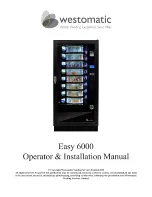
1-5
•
Protect yourself and others from flying sparks and hot metal.
•
Do not weld where flying sparks can strike flammable material.
•
Remove all flammables within 35 ft (10.7 m) of the welding arc. If this is not
possible, tightly cover them with approved covers.
•
Be alert that welding sparks and hot materials from welding can easily go
through small cracks and openings to adjacent areas.
•
Watch for fire, and keep a fire extinguisher nearby.
•
Be aware that welding on a ceiling, floor, bulkhead, or partition can cause
fire on the hidden side.
•
Do not weld on closed containers such as tanks, drums, or pipes, unless
they are properly prepared according to AWS F4.1 (see Safety Standards).
•
Connect work cable to the work as close to the welding area as practical to
prevent welding current from traveling long, possibly unknown paths and
causing electric shock and fire hazards.
•
Do not use welder to thaw frozen pipes.
•
Remove stick electrode from holder or cut off welding wire at contact tip
when not in use.
•
Wear oil-free protective garments such as leather gloves, heavy shirt, cuff
less trousers, high shoes, and a cap.
•
Remove any combustibles, such as butane lighters or matches, from your
person before doing any welding
.
FLYING METAL can injure eyes.
•
Welding, chipping, wire brushing, and grinding cause sparks
and flying metal. As welds cool, they can throw off slag.
•
Wear approved safety glasses with side shields even under
your welding helmet.
HOT PARTS can cause severe burns.
•
Do not touch hot parts bare handed.
•
Allow cooling period before working on gun or torch.
Summary of Contents for ARC-100S
Page 48: ...5 3 5 3 System Schematic ...
Page 49: ...5 4 5 4 Parts List ...
Page 53: ...5 3A 5 3 Esquema del sistema ...
Page 54: ...5 4A 5 4 Lista de piezas ...
Page 56: ......









































